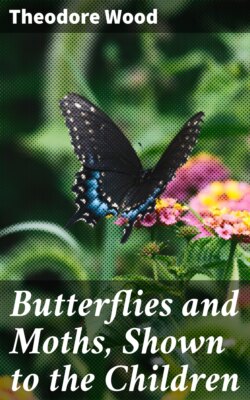Читать книгу Butterflies and Moths, Shown to the Children - Theodore Wood - Страница 5
На сайте Литреса книга снята с продажи.
ОглавлениеBUTTERFLIES AND
MOTHS
PART I
BUTTERFLIES
Table of Contents
PLATE I
THE SILVER-WASHED FRITILLARY (1)
Table of Contents
THE Fritillaries are handsome golden-brown butterflies, with black blotches and streaks on the upper surface of all the wings, and a number of beautiful silvery spots upon the lower surface of the hinder ones. Nine different kinds are found in Great Britain, but one of these—the “Queen of Spain”—is very rare indeed, and several others are very “local”; that is, they are only found in a few places, so that you are not likely ever to see them. But the Silver-washed Fritillary is common in almost every large wood. You may see it flying about on any warm sunny day in July and the early part of August. And it is very fond indeed of resting with outspread wings on bramble blossoms, while it eagerly sucks up their sweet juices.
The caterpillar of this beautiful butterfly feeds upon violet leaves. It is rather a curious-looking creature, for it is covered all over with thorny spikes, two of which, placed just behind the head, are a good deal longer than the others. In colour it is black, with yellow lines along the back and sides. About the end of May it hangs itself up by its tail to the stem of a bramble-bush, or some other low shrub, and turns into a fat, humpy, grey chrysalis, spotted all over with silver and gold.
PLATE I
THE PEARL-BORDERED FRITILLARY (2)
Table of Contents
This butterfly is only about half as big as the “silver-washed fritillary,” for its wings hardly ever measure more than an inch and three-quarters across. It is very common indeed in woods, where you may see it flitting about in almost every open space, first in May, and then again in August. Sometimes, too, you may notice it flying along a hedgerow by the roadside. The caterpillar, which feeds upon the leaves of the dog-violet, is black, with white dots and lines, and the chrysalis is greyish-brown, with paler spots upon the sides.
There is another fritillary, called the “Small Pearl-bordered,” which is very much like this butterfly. But you can easily tell the one from the other. All that you have to do is to look at the lower surface of the hind-wings. For in the Pearl-bordered Fritillary there are only nine silvery spots on these wings, while in the small Pearl-bordered there are no fewer than seventeen.
This butterfly also lives in woods, and the two may often be seen flying about together.
